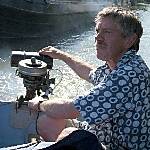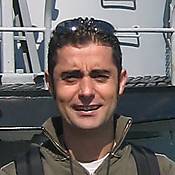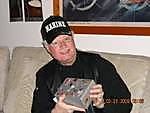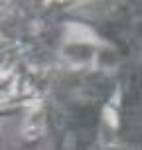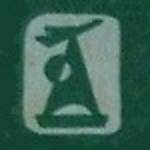You are viewing the archived version of the site.
Go to modelshipwrights.com for the current dynamic site!
Go to modelshipwrights.com for the current dynamic site!
1⁄350USS Lexington (CV2) 1927-1942
23
Comments
Stage 12: radar cabin
Kit parts: 2
Scratch parts: 4
PE parts: 2
Time: 2 hours
The radar cabin on the front of the stack appeared very mis-proportioned but I had no drawing references to check this against. From photographic evidence it appeared to be similar, if not identical, to the radar cabin on the Saratoga at this time. So I used this as the reference. For a start it appears too wide. I dealt with this by cementing the top and bottom halves together and, when it was thoroughly set, sawed 1.5mm wide through the centre, top to bottom, then glued the two vertical halves together.
The cabin also appears too long, so, again, when thoroughly set, I sawed off the complete concave rear section. This was then reshaped to a slight convex to match the face of the stack. For obvious reasons the radar cabin had no windows, so these were filled in. When cemented in place, the gaps in the face of the stack were filled and profiled – always easier said than done. A manhole cover was mounted on the roof, giving access to the PE ladder running up the front of the stack to the gun gallery above. Two supporting brackets beneath the cabin made from styrene sheet completed the assembly. A PE vertical ladder was fitted to the front of the stack between the bottom of the cabin and the platform below it. A cable trunk for the CXAM radar (stretched sprue) was run between the cabin roof and the top of the stack (see photos above).
Stage 13: water tank
Scratch parts: 12
Time: 1 hour
The structure between the 1.1-inch mount at the forward end of the structure and the stack was in profile a rectangular, and in plan a trapezoid, fresh water tank. Before the 1.1-inch mount was shipped, the platform on top of the tank extended forward and mounted two pairs of 6-pdr saluting guns. Because of the space required for the 1.1-inch mount, this extended platform was cut back. The parts in the kit do not resemble this tank structure at all so parts C19, C20, C21 and C22 were discarded. A new tank (including two manhole covers on the roof) was made up from styrene sheet. As the Lexington never shipped any 1.1-inch directors in any part of the ship (they were available but there was no time to mount them during her final, short refit), parts F20 and F24 were saved for use elsewhere.
Below the water tank was a winch motor room. There was one winch on the port side of the structure and two on the starboard side, all on the horizontal axis. These were fabricated from styrene rod and strip. There was a vertical jack rod (stretched sprue) between the two scuttles forward of the winch on the port side.
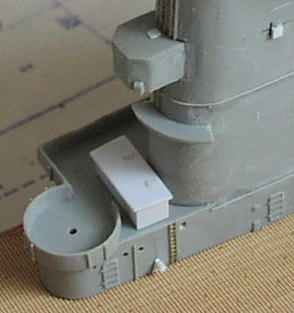
Above: water tank and winch, with radar cabin above.
Stage 14: stack cowling
Kit parts: 1
Scratch parts: 22
PE parts: 4
Time: 3 hours
The stack cowling (part D8) required substantial work. The over-sized ‘wings’ on each side were cut back so that there was a small amount of overhang relative to the stack below. This overhang ran right round the cowl, so styrene strip was cemented around the curved ends to build this up. Narrow slots ran the length of the top of the stack on each side immediately below the cowl to ventilate hot air from inside the stack.
These could have been created by cutting material away, but any mistakes would have been difficult to rectify. Instead, I raised the cowl, resting it on 1.5mm high supports at each end faired into the curved ends of the stack. This was done after reducing the height of the stack by the corresponding amount – easily done by sanding it down on a flat surface. With the locating ribs on the underside of the cowl now redundant, these were cut away. The top of the cowl was carefully profiled to give a sharp edge to the overhanging lip all round, and this was helped by sanding the underside flat. The lip along the bottom of the ventilation slots was fashioned from brass wire.
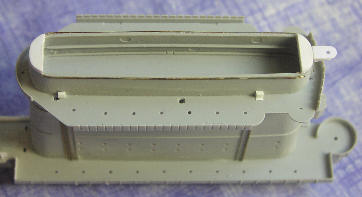
Above: Stack modifications, starboard side.
Having cut away the plastic grills in the uptake apertures and tidied up the openings to make the coamings thinner, I was presented with a splendid view of the expansive interior of the stack right down to the upper gun gallery level. Believing that this would be visually unacceptable when the model was finished, I fashioned the boiler uptakes (‘smoke pipes’ in US naval architecture parlance) from styrene sheet. The jack rod round the top edge of the cowl was fashioned from brass wire. Two access hatches were fitted outboard of uptakes no. 1 and 3, the latter in the open position for added interest.


Above: Completed stack cowl.
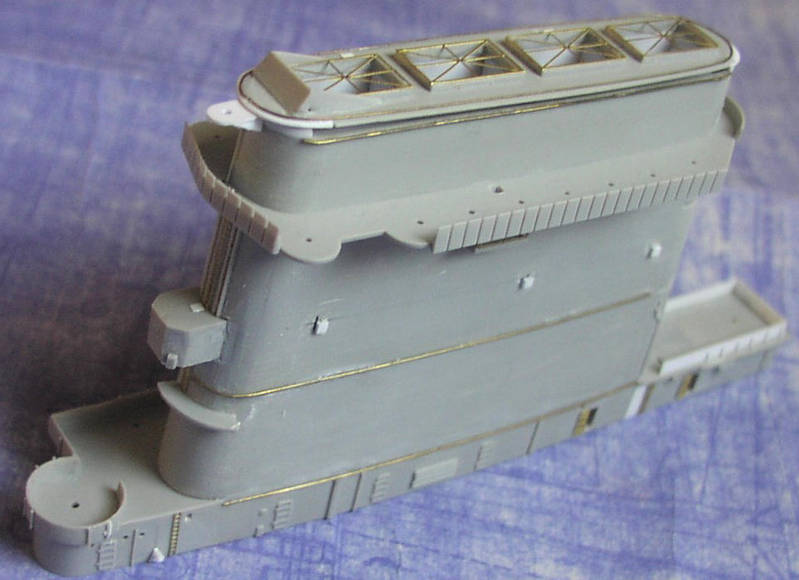
Above: Stack and cowl assembly.
Comments
Hi Joseph,
Yeah, it was a lot of research. I was DETERMINED to make it abolutely as accurate as possible. What I don't understand is how Trumpeter got so much of it grotesquely wrong. Anyway, thanks for your comments. I sure hope you find my feature useful - from what I've seen the 1:700 from Trumpeter is just a scaled down version of the 1:350 kit, including everything that's wrong with the big one!
JUL 08, 2008 - 05:36 AM
Hi Rui
Well, well, well. I used to be a graphic designer myself as well. And a copywriter. Hence what I hope is a deal of professionalism in my SBS guide.
The whole project spanned two years. I didn't dare start another model in all that time, knowing it would simply delay completion and possibly I would lose my motivation. Sometimes it was very hard to keep going - the progress when doing the armament and the air group seemed so slow. I really had to force myself to keep going.
Thanks for the advice on using Clearcoat on the decals. Actually, that is what I did use, in order to soften the decals so they would lay close on the curved fuselage sides, to get them to stick, and to try and dull them down. All the planes were matt varnished as well, but that still didn't kill the decal edge reflection.
You can see some of my 1:700 stuff at: LINK If you select my name from the top of the menu on the left you can see all my galleries.
By the way, the 1:700 Trumpeter Lexington looks like just a scaled-down version of the 1:350 version, including everything that is wrong and inaccurate. So please, please, do use all the research I did to get it right. I look forward to seeing the result!
Regards, Chris
JUL 08, 2008 - 05:48 AM
Jim
Your comments an honour indeed. I have followed your work over the years at Modelwarships.com and you really are the best. Counting the hours is actually a way of giving myelf a sanity check! Which is why to some extent the whole project took me two years from start to finish.
Regards, Chris
JUL 08, 2008 - 05:53 AM
Thanks for taking time to answer to my questions!
I have the 1/700 Trumpeter model, for Coral Sea fit, so I guess you have done all the research for me - but still, I have to get the work myself!
Not for now, but for a "near" future (I am currently working on three projects, one a full scratch all in 1/700).
Thanks for the link, and since my memory is better for graphics, than for names, I can say that I had already seen your Sara / Lex duo in MW.
Please keep up - keep your ship models afloat!
Rui
JUL 08, 2008 - 05:57 AM
Are you sure that thing is a model. It looks so real. In some of those photos it looks too real. Nice job. Amazinglly nice job. Great tribute to those who sailed, fought and died on board the original Lady Lex carrier. Nice work.
JUL 11, 2008 - 08:46 AM
Hi Chris,
Sorry no plans on any new 1/350 items.
You could use my YC-728 or 829 for an open ammunition lighter. I have some photos of their use as such.
JUL 15, 2008 - 07:06 AM
Hello Chris:
I just finished reading your build log. Outstanding work and very well written. I have this kit, not sure I want to tackle all the inaccuracies vice just building an OOB kit, but, your work is inspirational and you presented a lot of neat ideas to enhance the kit. I will be referencing your build log when I tackle mine. Thanks for posting and sharing.
FEB 10, 2015 - 08:49 AM
Mark, I doubt Chris will respond as this is a 7 year old tread and Chris last signed in 7 years ago.
FEB 10, 2015 - 09:13 AM
wow, awesome model building.
well worth resurrecting the thread and feature.
FEB 11, 2015 - 09:17 AM
Copyright ©2021 by Chris Smithers. _OPINIONS Model Shipwrights, KitMaker Network, or Silver Star Enterrpises. Images also by copyright holder unless otherwise noted. Opinions expressed are those of the author(s) and not necessarily those of Model Shipwrights. All rights reserved. Originally published on: 2008-07-04 00:00:00. Unique Reads: 23646






